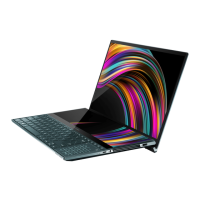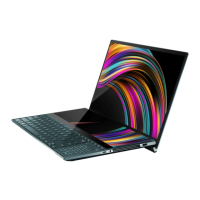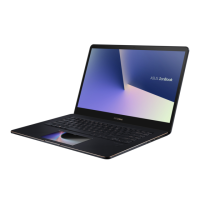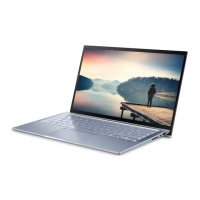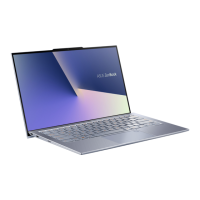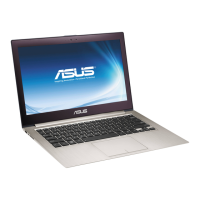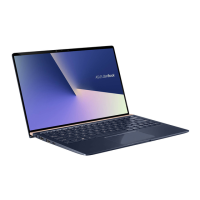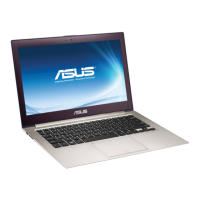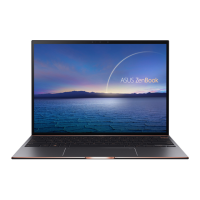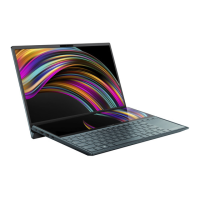
Do you have a question about the Asus ZenBook Duo UX481FL and is the answer not in the manual?
| Model | ZenBook Duo UX481FL |
|---|---|
| Category | Laptop |
| Operating System | Windows 10 Home |
| Processor | Intel Core i7-10510U |
| Graphics | NVIDIA GeForce MX250 |
| Memory | 16GB LPDDR3 |
| Color | Celestial Blue |
| Wireless | Wi-Fi 6 (802.11ax) |
| Bluetooth | Bluetooth 5.0 |
| Storage | 1TB PCIe SSD |
| Display | 14-inch Full HD (1920 x 1080) |
| Secondary Display | 12.6-inch ScreenPad Plus (1920 x 515) |
| Battery | 70Wh 4-cell lithium-polymer |
| Weight | 1.5 kg |
| Dimensions | 323 x 223 x 19.9 mm |
| Ports | 1 x HDMI |
| Audio | Harman Kardon certified |
| Camera | HD IR camera |
Legal notices regarding manual usage and ASUS's responsibility.
Information on obtaining technical assistance and support.
Introduces the manual's chapters and sections.
Explains special text formatting, icons, and notes.
Guidelines for safe usage, temperature, and handling.
Instructions on cleaning and avoiding damage from liquids or dust.
Guidance on proper disposal of the product and battery.
Introduction to the notebook's physical layout.
Details components visible from the top of the notebook.
Describes audio input and visual devices on the top.
Describes the screen and cooling system on the top.
Details primary input and control devices on the top.
Details on the bottom side, including heat and battery notes.
Identifies cooling vents and audio output on the bottom.
Identifies audio output and system status lights on the right.
Describes memory card, audio, and USB ports on the right.
Details the DC input port and associated warnings.
Describes HDMI and USB Type-C ports on the left.
Step-by-step guide for initial charging.
Basic operations for opening the lid and starting the PC.
Explains basic touch screen gestures for navigation.
Details tap, double-tap, and zoom gestures on the touch screen.
Explains scrolling and drag operations on the touch screen.
Instructions for moving the cursor using the touchpad.
Explains single-finger tap, double-tap, and drag-and-drop.
Explains left, right, and two-finger click functions.
Explains scrolling and zoom gestures using two fingers.
Explains drag-and-drop and three-finger tap for Cortana.
Explains swipe gestures for switching apps and showing the desktop.
Explains four-finger tap and how to customize touchpad settings.
Explains function keys for volume, brightness, etc.
Explains other hotkeys and function key behavior.
Describes Windows key functions.
Explains other special function keys.
Guide for first-time setup.
Explains the Start menu's role and common uses.
Methods to open and use the Start menu to launch apps.
Describes tiled apps for quick access.
How to open, move, and modify apps.
How to adjust app tile size and remove from Start.
How to add apps to the taskbar or Start menu.
Switching between apps and virtual desktops.
Displays apps side-by-side using snap hotspots.
Step-by-step guide for snapping applications.
Methods to open the Action Center and its quick actions.
Key combinations for launching system features.
Key combinations for search, display, and system functions.
Step-by-step instructions for connecting to Wi-Fi.
Process for connecting Bluetooth-enabled devices.
How to activate or deactivate airplane mode.
Methods for turning off the PC.
Methods to put the PC into sleep mode.
Explains POST diagnostics and BIOS settings.
Methods to enter the BIOS setup.
Pre-recovery steps including backup.
Lists recovery types like 'Keep my files' and 'Advanced startup'.
Step-by-step guide for system recovery via Settings.
General tips for optimal usage and data security.
Solutions for screen display and brightness issues.
Advice on extending battery duration.
Solutions for charging indicator and touchpad problems.
Solutions for sound issues and power adapter problems.
Troubleshooting for typing and cursor problems.
Solutions for blank screens and startup errors.
Solutions for boot failures and sleep mode issues.
Details on modem certifications and regulations.
Explanation of the CTR 21 standard for telecommunication equipment.
Statements on network compatibility and definition of non-voice equipment.
Lists countries covered by the CTR 21 standard.
Statements on FCC compliance and RF exposure.
Statements on ISED compliance and operational cautions.
Details on SAR limits and compliance for RF exposure.
Safety guidelines related to UL standards for electrical and battery safety.
Requirements for power cords and hearing loss prevention.
Cautions for lithium-ion battery handling in multiple languages.
Approval details for modem connectivity in various languages.
Declarations for EU, Japan, and India environmental regulations.
Information on ASUS recycling programs and EU Ecodesign.
Details on energy efficiency and environmental ratings.
Regional compliance and battery warnings.
Declaration of compliance and WiFi usage limitations for specific countries.
